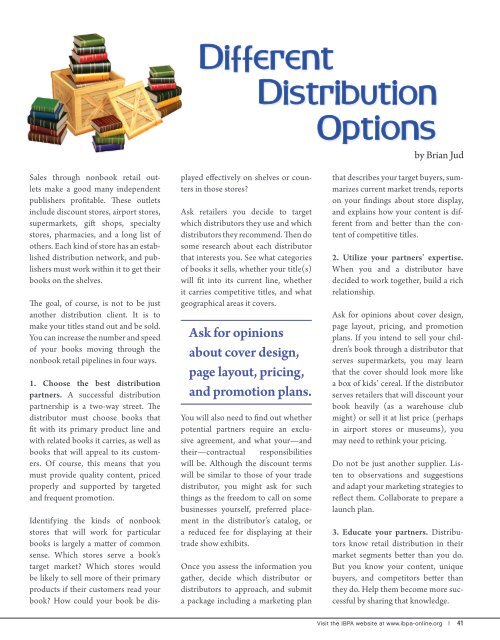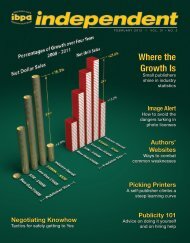Book- Business Lingo
Book- Business Lingo - Van-garde
Book- Business Lingo - Van-garde
You also want an ePaper? Increase the reach of your titles
YUMPU automatically turns print PDFs into web optimized ePapers that Google loves.
DifferentDistributionOptionsby Brian JudSales through nonbook retail outletsmake a good many independentpublishers profitable. These outletsinclude discount stores, airport stores,supermarkets, gift shops, specialtystores, pharmacies, and a long list ofothers. Each kind of store has an establisheddistribution network, and publishersmust work within it to get theirbooks on the shelves.The goal, of course, is not to be justanother distribution client. It is tomake your titles stand out and be sold.You can increase the number and speedof your books moving through thenonbook retail pipelines in four ways.1. Choose the best distributionpartners. A successful distributionpartnership is a two-way street. Thedistributor must choose books thatfit with its primary product line andwith related books it carries, as well asbooks that will appeal to its customers.Of course, this means that youmust provide quality content, pricedproperly and supported by targetedand frequent promotion.Identifying the kinds of nonbookstores that will work for particularbooks is largely a matter of commonsense. Which stores serve a book’starget market? Which stores wouldbe likely to sell more of their primaryproducts if their customers read yourbook? How could your book be displayedeffectively on shelves or countersin those stores?Ask retailers you decide to targetwhich distributors they use and whichdistributors they recommend. Then dosome research about each distributorthat interests you. See what categoriesof books it sells, whether your title(s)will fit into its current line, whetherit carries competitive titles, and whatgeographical areas it covers.Ask for opinionsabout cover design,page layout, pricing,and promotion plans.You will also need to find out whetherpotential partners require an exclusiveagreement, and what your—andtheir—contractual responsibilitieswill be. Although the discount termswill be similar to those of your tradedistributor, you might ask for suchthings as the freedom to call on somebusinesses yourself, preferred placementin the distributor’s catalog, ora reduced fee for displaying at theirtrade show exhibits.Once you assess the information yougather, decide which distributor ordistributors to approach, and submita package including a marketing planthat describes your target buyers, summarizescurrent market trends, reportson your findings about store display,and explains how your content is differentfrom and better than the contentof competitive titles.2. Utilize your partners’ expertise.When you and a distributor havedecided to work together, build a richrelationship.Ask for opinions about cover design,page layout, pricing, and promotionplans. If you intend to sell your children’sbook through a distributor thatserves supermarkets, you may learnthat the cover should look more likea box of kids’ cereal. If the distributorserves retailers that will discount yourbook heavily (as a warehouse clubmight) or sell it at list price (perhapsin airport stores or museums), youmay need to rethink your pricing.Do not be just another supplier. Listento observations and suggestionsand adapt your marketing strategies toreflect them. Collaborate to prepare alaunch plan.3. Educate your partners. Distributorsknow retail distribution in theirmarket segments better than you do.But you know your content, uniquebuyers, and competitors better thanthey do. Help them become more successfulby sharing that knowledge.Visit the IBPA website at www.ibpa-online.org | 41








